Marijuana And Its Adverse Effects On The Brain, Health, And Life
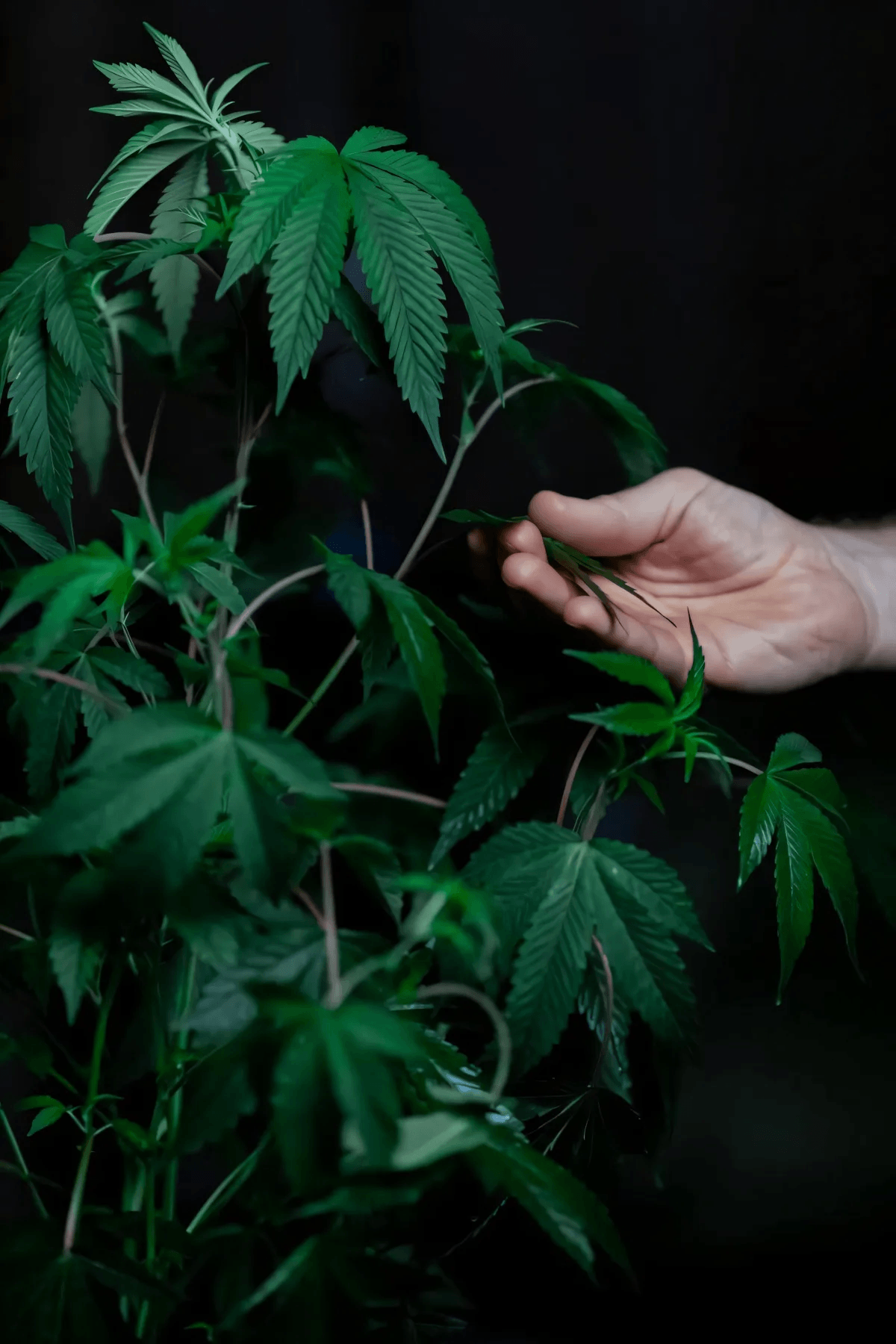
Marijuana is a common street and recreational drug that is becoming one of the most abused drugs worldwide after tobacco and alcohol. It refers to the dried leaves, flowers, stems, and seeds of the Cannabis Sativa or Cannabis Indica plant. It contains a mixture of the dried flowers of this plant.
There are more than 500 chemicals in this drug. The chemicals (THC or tetrahydrocannabinol) are psychoactive that cause intoxication or mind-altering effects, making their users feel "high."
The ingredients that contain the drug are mainly found in the flowers, which are usually called "buds," and less in stems, leaves, seeds of the Cannabis sativa plant.
Marijuana is called with many slang terms, such as weed, pot, dope, herb, grass, Mary Jane, and others. When it is sold in the street, is just a mixture of dried leaves, flowers, seeds, and stems in a greenish-gray color.
How do people use marijuana?
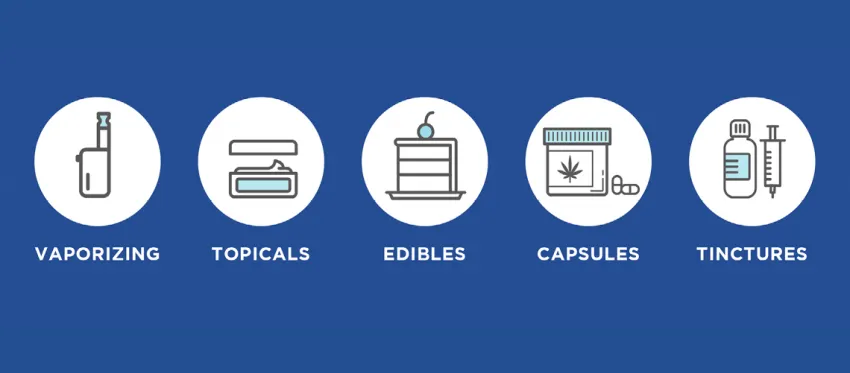
Marijuana is becoming more potent than it was in the past. People are finding and creating new ways to get a long-lasting "high" feeling. We don't know every methods marijuana is being used, but it matters to educate yourself about it. Marijuana can be used in various ways, not only by smoking just like cigarettes.
1. The most common way of using marijuana is smoking.
They roll it into a cigarette by using tobacco leaves which are called joints. They may also use blunts, hollowed cigars filled with marijuana, bongs, water pipes, bubblers, mini-bongs, and hookah.
2. Vaporization is a new method for using marijuana.
They heat marijuana below the point of combustion and inhale the vapor instead of the smoke. They do this because they believe it gives them a better "high," produces less smell than smoking, and is easier to conceal.
3. Another technique is gravity bongs.
They are homemade pipes that use the gravity force to pull the marijuana smoke into the chamber. They generally use water for this, but others may use beer or other liquids. To do this, they use plastic bottles, milk cartons, or cans.
4. Dabbing is the action of inhaling vaporized cannabis.
It is made by THC using a solvent like a dioxide Carbone or butane. They are called butane hashed oil, wax, budder, and shutter. Dabbs is heated on a hot surface and then smoked in a dab rig. This form of THC is more potent giving you a more intense "high."
5. Oral ingestion is using marijuana oil to cook with food.
This oil can be used in cooking, baking, or simply mixed with any kind of food. They are creating food products like gummies, cakes, cookies, and even chewing gum. Some use marijuana oil on beverages. Vendors sell teas, beers, and sodas. People have used marijuana to make teas for many years, however, nowadays this tea is more potent.
What are the short and long-lasting negative effects of marijuana?
Short-term effects of marijuana.
- Anxiety and paranoia of being followed.
- Short-term memory problems.
- Losing contact with reality (psychosis).
- Panic and hallucinations.
- Loss of their sense of personal identity.
- Lowered reaction time and problems with coordination.
- Increased heart rate and risk of stroke.
- Sexual problems and higher chances of STD.
Long terms effects of marijuana.
- Decline in IQ, poor school performance, and dropping out.
- Impaired thinking and ability to learn and perform tasks.
- Addiction and potential opioid abuse.
- Antisocial behavior, including stealing money and lying.
- Financial difficulties and lower chances of employment.
An overall of marijuana's negative effects on health
Marijuana is a recreational drug used by many adults for enjoyment, leisure purposes, or even to numb pain and relieve stress. Science has proven that it can have devastating effects on the users' health. It can harm brain health, heart, bones, lungs, cancer risk, and child development if exposed during pregnancy.
1. Marijuana affects the brain.
Marijuana has the psychoactive ingredient THC that causes intoxication and mind-altering effects. It attaches itself to the brain cannabinoid receptors which connect to the nerves of the brain responsible for memory, pleasure, thinking, concentration, sensory and time perception, and body coordinated movement.
The short-term effects on the brain are that it affects short-term memory, attention, concentration, and reaction time, which leads to problems with relationships and mood disorders.
While on the long term marijuana directly affects the brain and how the brain builds connections between areas necessary for its functioning such as attention, memory, and learning.
These effects can last for a very long time, but sometimes the risk is that they can be permanent, which means that it will affect the users' performance in school and work.
2. Marijuana causes psychiatric disorders.
As per the researches conducted by scientists, there is a correlation between marijuana use and psychiatric disorders, including psychosis (schizophrenia), depression, anxiety, and substance abuse.
The chances of developing psychosis are 5 times higher for a marijuana user than someone who never used it. But it is worth mentioning that other factors must be taken into consideration such as age, how often it has been used, and genetic factors.
Another study has revealed that the AKT1 gene is responsible for developing psychosis 7 times more in users, than in people who never tried it or have used it rarely. Studies show that Marijuana use can worsen the symptoms of people who are already diagnosed with mental disorders.
The studies reveal also that people who quit using marijuana, after a withdrawal psychotic symptom, have fewer psychotic episodes comparing with people who continue using this drug. This leads them to an improvement of overall performance in daily life and life satisfaction.
3. Marijuana may cause cancer.
Marijuana has been used for medical reasons for centuries, but nowadays its chemicals are being studied if they can be used in medicine or not. Currently, the US Drug Enforcement Administration (DEA) considers marijuana and its chemicals as Schedule I controlled substances, meaning that it cannot be prescribed, sold, or possessed legally under federal law.
Marijuana, in any form, cannot be sold because it is not approved by the US Food and Drug Administration (FDA), while in some states it is legalized its use to treat certain medical conditions.
The American Cancer Society says that more research is necessary for the use of marijuana in medicine. Using it to relieve pain, and negative symptoms in patients with cancer, should not cause more damage than benefit, due to the negative side effects.
4. Marijuana damages the heart.
Scientists are well aware that marijuana use and cardiovascular health in people who are experiencing stress develop chest pain faster and at a higher rate than those people who don't use it. This happens because of the effect cannabinoids have on the cardiovascular system, including increasing resting heart rate, dilating blood vessels, and making the heart pump harder.
Studies suggest that the risk of heart attack is higher after the hour of using cannabis than it would be normally. Even though it is not a big threat, still people with heart diseases must take this information seriously.
As per the researches that show there is a correlation between stroke and marijuana use consistent with this evidence, Dr. Kenneth Mukamal, and his colleagues suggest that smoking marijuana may increase the death rate among heart attack survivors.
5. Marijuana causes damages to the lungs.
Any kind of smoke is harmful to lung health, whether it comes from burning wood, tobacco, or marijuana. The toxins and cancer carcinogens marijuana smoke combustion carries are the same as tobaccos'.
Besides this, marijuana is smoked differently than tobacco. Marijuana smokers inhale more deeply and tend to keep the smoke longer in their lungs, exposing their lungs for a longer time to tar.
It clearly damages the lungs by causing chronic bronchitis, injuring the cells of the large lining airways, leading to symptoms such as chronic cough, phlegm production, wheeze, and acute bronchitis.
Marijuana smoke kills the cells that protect the organism from infections, that remove dust and germs. Marijuana use affects the body's immune system and the body's ability to fight diseases, such as HIV AIDS.
6. Marijuana causes bone damages.
Prof. Stuart Ralston, at the Centre of Genomic and Experimental Medicine at the University of Edinburgh, quotes: "We have known for a while that the components of Cannabis can affect bone cell function, but we had no idea up until now of what this might mean to people who use cannabis regularly."
When scientists compared the bone density of marijuana users and people who don't use it, they found significant differences. They saw a 5 percent reduced density in the bone structure of heavy users of marijuana, comparing with people who never used it, or have used it very early. When bones lose density, they become fragile risking osteoporosis and bone fractures.
7. Problems with child development during and after pregnancy.
Marijuana is becoming a widespread drug even among pregnant mothers who due to the lack of information consider it as less harmful or not harmful at all. for this reason, it is essential to understand the risks and impacts it has on developing fetuses.
As per the large-scale longitudinal research studies have revealed that these children develop neurological problems of hyperactivity and impulsivity, behavioral issues, lower IQ scores, and memory problems compared to children of nonuser mothers.
These problems persist through the teenage years and adulthood affecting their day-to-day performance, making them more prone to attention problems, depression, and criminal behavior.
Is marijuana addictive?
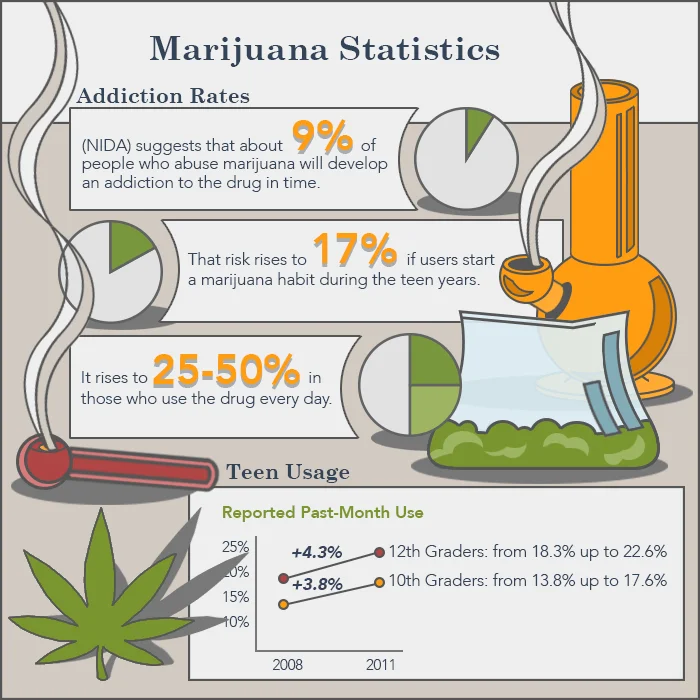
Using marijuana can developing marijuana use disorders, which takes the form of addiction. Studies reveal that 30 % of people who consume marijuana, develop this disorder if they started using it during adulthood, while if they started using it in their teens the chances are 4-7 times higher. This disorder is correlated to dependency, which means feeling withdrawal symptoms if stop taking this drug.
Users feel irritable, mood and sleep difficulties, loss of appetite, cravings, and various symptoms of physical discomfort within the first weeks lasting up to two weeks after quitting marijuana.
This dependence happens when the brain adapts to a large amount of drug by reducing production and sensitivity to its own endocannabinoid neurotransmitters. Marijuana users cannot quit the drug even though this addiction affects their life in many aspects.
Can marijuana be a getaway drug?
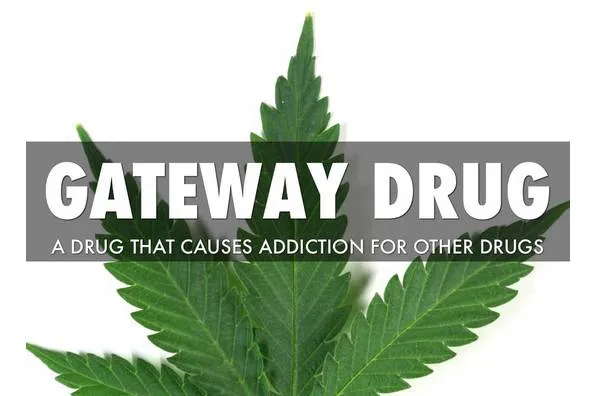
Many people do not think of marijuana as a "getaway" drug, considering it just a rather as a relic of previous decades' war on drugs. However studies reveal there is a correlation between marijuana and other drugs, but to evaluate this more researchers are necessary.
The reason for it is that after buying marijuana, the chances of being offered other drugs are higher, or the types of the personality of people who buy marijuana urge them to try harder drugs. But to have an accurate evaluation of this we must take into consideration social factors, personality characteristics, and the effects of other drugs.
Can secondhand marijuana smoke affect nonsmokers?
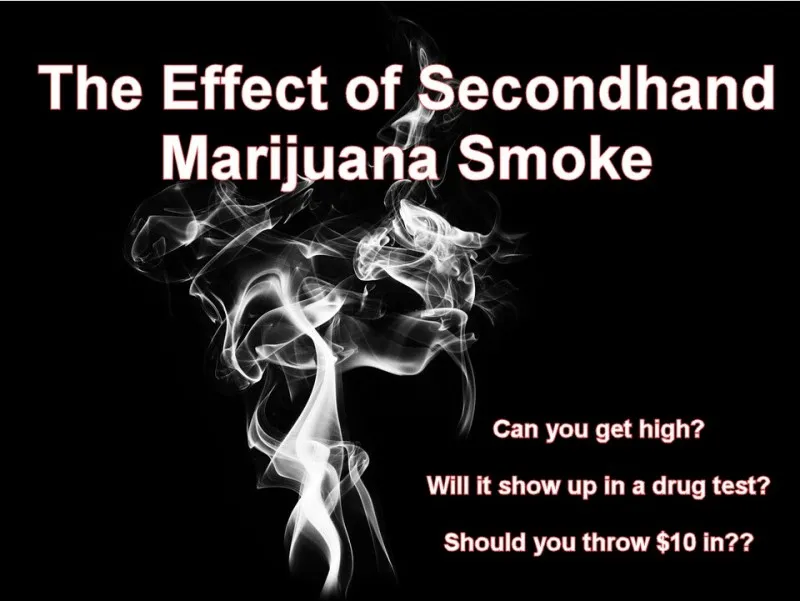
It is very unlikely to be affected by marijuana smoke unless you are in a confined place with lots of smoke, but still, you will not experience a "high." Studies show that people who are around marijuana smokers experience only mild effects under extreme conditions (being in a closed room with many smokers for long hours).
Scientists have to conduct more research to determine the other side effects of secondhand marijuana smoke. The same chemicals that are found in tobacco smoke are found in marijuana smoke too, but what scientists are certain about is that it affects vulnerable people, children, and those who suffer from asthma.
The effects of marijuana have over school, work, and social life
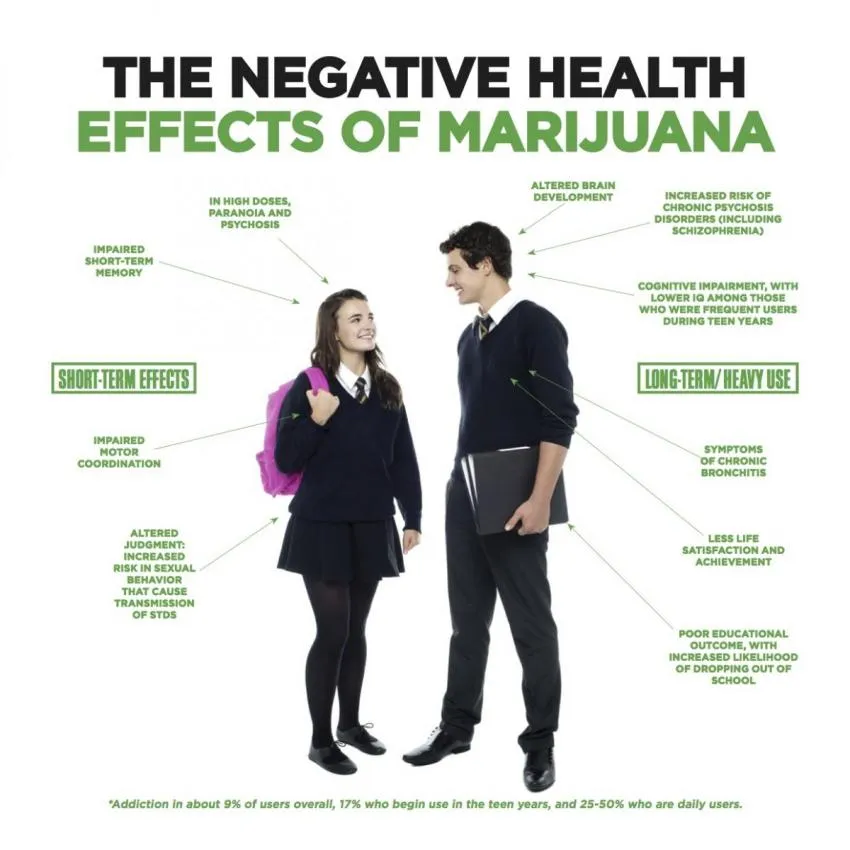
Research shows that the negative effects marijuana has on attention, memory, and learning last for days or weeks after acute effects, of the drug wear off, varying on the user's history.
As a consequence daily users of marijuana have a lower performance of their mental capacities. Students who smoke marijuana have lower outcomes in school fewer chances of graduating comparing with their peers.
They have higher chances of becoming dependent, start using other drugs, and committing suicide. Using marijuana links to lower-income, greater welfare dependence, unemployment, criminal behavior, and less life satisfaction.
Marijuana's correlation to suicide
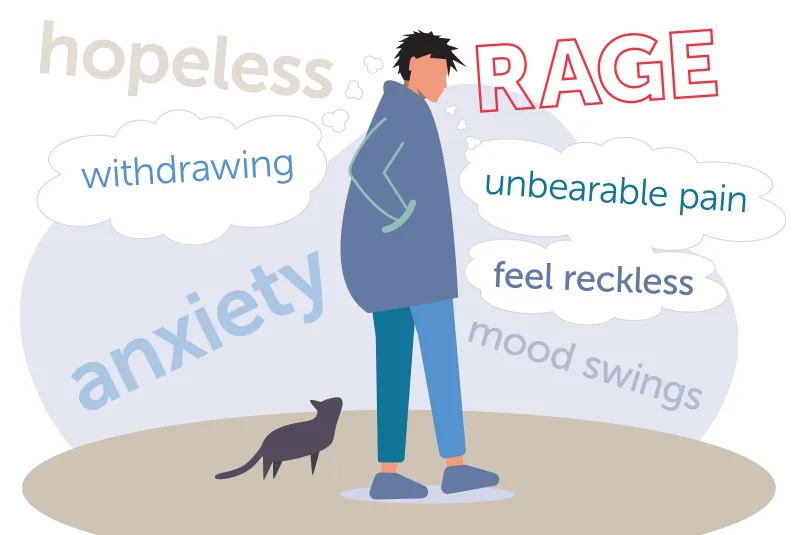
After 18 months since the first marijuana shop was opened in Michigan, the federal government links an increase in suicide number among marijuana users.
The National Institute on Drug Abuse conducted research among 280,000 people from 18-35 who considered thought about suicide, planned suicide, or attempted it more often than nonusers. After legalizing marijuana use for recreational purposes the number of its users went from 22.6 million in 2008, to 45 million in 2019.
Even though the report doesn't say that marijuana leads to suicidal thoughts or actions, they are making us understand that marijuana users have higher risks of suicidal thoughts or actions. Data was revealed from researchers who analyzed four groups of people, nonusers, those who use it, but not daily, daily users, and addicted to it.
The conclusion: For people who did not have depression or a history of depression, three percent of people who do not use marijuana had suicidal thoughts, seven percent of nondaily users had suicidal thoughts, nine percent of daily users, and fourteen percent of addicted.
While among those people who had depression the rates were higher. 35% for nonusers. 44% for nondaily users, 53% for daily users, and 50% for addicts.
Available treatments for marijuana use disorders
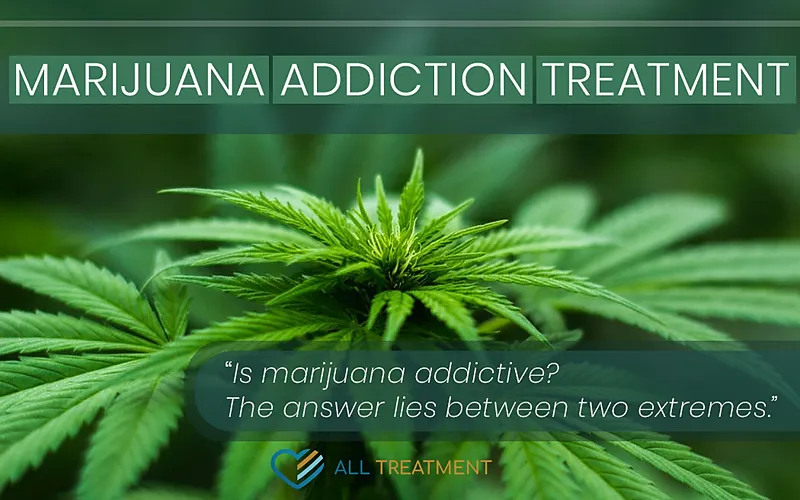
Studies indicate that treating mental disorders through medications and therapies can decrease marijuana use among heavy users and users with mental disorders. The following behavioral treatments have given the results:
- Cognitive-behavioral therapy: A form of psychotherapy that helps people to understand and correct their problematic behavior to have better control o themselves, stop using drugs, and approach other problematic attitudes that co-exist.
- Contingency management: It consists of continual monitoring of the target behavior and providing positive rewards when the target behavior occurs or not.
- Motivational enhancement therapy: It is a systematic intervention to motivate the patients within themselves; this treatment does not attempt to treat the person, but rather to find within himself the internal potential for change.
So far, the Federal Drug Administration has not approved any medication that treats marijuana use disorder, but scientists are doing active research on this field.
What to do if your child is using marijuana?
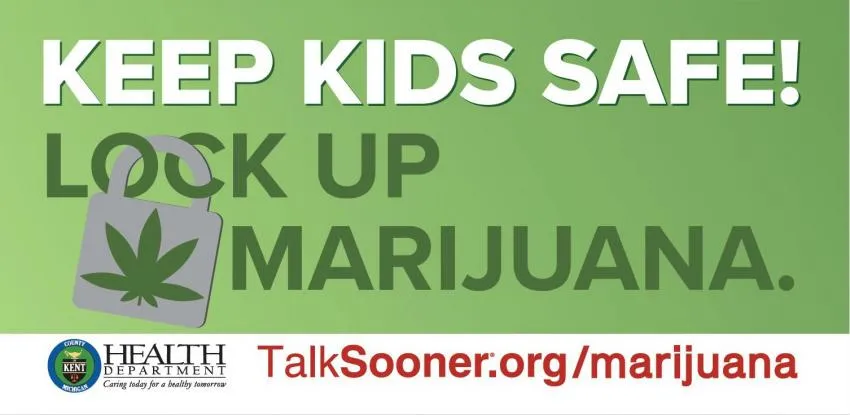
If you suspect your child using marijuana and you find him actively using it, you are halfway to success because you are aware of what is happening. But what should you do next? The Partnership for Drug-Free Kids encourages you to proceed as follows:
- Be clear that drug use will never be accepted or tolerated. It is critical to implement repercussions to understand how critical the situation is.
- Give chances to reconnect the bond of trust, like supervising homework and chores, but also giving positive feedback for a well-done job.
- Be responsive to their efforts, only a punishing attitude can jeopardize and damage your relationship
- If a friend is involved, contact the parent. They need to do the same for their child as you do for yours, and it will create a conversation around this issue.
If the child is using then you can follow these steps:
- Understand and watch out for side effects, their reactions, toxicity, or withdrawal symptoms.
- Start learning about the behavioral signs of marijuana use.
- Be suspicious about hiding places for marijuana.
The physical and psychological signs are the same as the side effects. These effects wear off after two hours, and for this cause, parents can not spot if their children are using marijuana. To identify if your child is using marijuana, look for these signs:
- Red eyes.
- Forgetfulness.
- Headache and dizziness.
- nausea or vomiting.
- panic or anxiety.
- Hallucinations.
When parents have no more doubts that their child is using marijuana, then approaching their child in order not to have an escalation. It is important to ask the help of a professional therapist, start educating your family and be part of family or community gatherings online.
Is marijuana safe and effective as medicine?
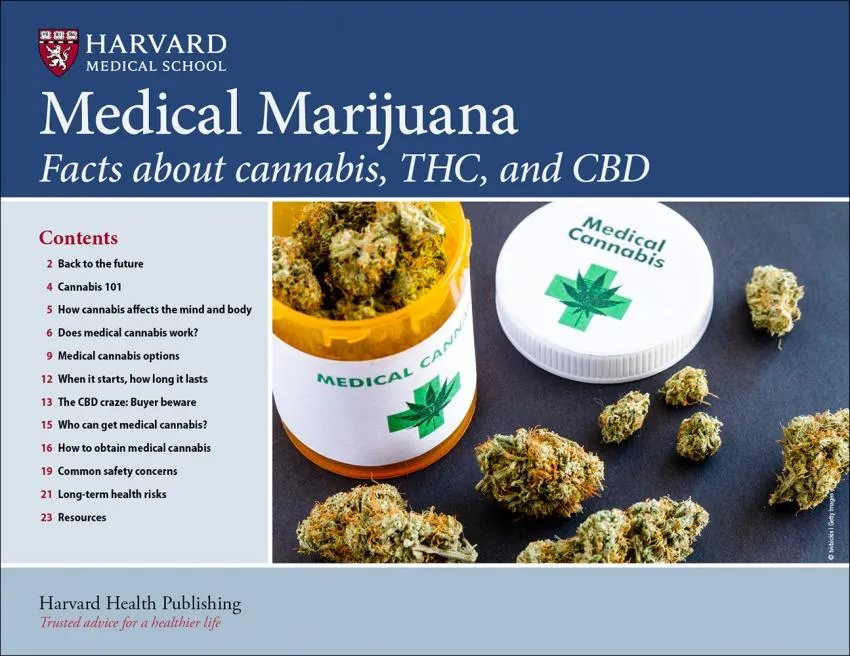
The most widespread use of marijuana for medical reasons is pain control or relief. It's not strong enough for severe pains like broken bones, or post-surgical pain, nevertheless it is effective for chronic pain, especially with aging. Part of the myth is that people believe it is safer than opiates (you can never overdose on and less addictive) and it can replace Advil or Aleve to avoid kidney problems and ulcers or GERD.
It is a pain reliever for multiple sclerosis, nerve pain whereas other options like Neurotin, Lyrica, or opiates are highly sedating. People who use marijuana instead claim it makes them follow their day-to-day activities without feeling out of it or disengaged.
Another reason people may use it for relaxing their muscles, for it relieves tremors in Parkinson's disease. Scientists are researching to use of marijuana for PTSD in veterans coming back from war zones. Besides this, other areas are promising for marijuana use in medicine, but as with every medication it must be critically evaluated and treated with caution.
If it can find application in medicine, then it has to be critically evaluated by experts, and proscribed by the experts only. If you want to self-medicate, there are higher chances you will harm and cause irreversible damages to yourself.
A story of how marijuana use destroyed someone's life.
"I started using on a dare from a best friend who said I was too chicken to smoke a joint and drink a quart of beer. I was fourteen at that time. After seven years of using and drinking, I found myself at the end of the road with addiction. I was no longer using to feel euphoria, I was just using to feel some semblance of normality.
Then I started having negative feelings about myself and my own abilities. I hated the paranoia (suspicion, distrust, or fear of other people). I hated looking over my shoulder all the time.
I really hated not trusting my friends. I became so paranoid that I successfully drove everyone away and found myself in the terrible place no one wants to be - I was alone. I'd wake up in the morning and start using and keep using throughout the day." - Paul.
Marijuana is one of the most widespread drugs in the world and here in the US. Even though the illusion that is created around it makes it looks harmless, or fun substance, it always remains a drug that changes the brain, in many cases with significant consequences. The long-term lasting effects it has on the brain, make it a dangerous drug whose negative effects are visible years later.
Educating ourselves about the negative side effects of marijuana is more important than ever because the laws related to marijuana are becoming softer and softer.
Across the US, there are many states, such as Nevada, Alaska, California, and many others that allow people over 21 to use marijuana for recreational purposes.
However, some states allow marijuana for medical purposes, such as migraines, epilepsy, anxiety, and cancer. Decriminalizing it means people will not have to go to jail for it.
Whether It's legal or not, using it for medical purposes or recreational ones, it is of great interest to have a thorough education on how it impacts us in all walks of life, because even though this drug is being studied for medical purposes, its potential abuse remains.
References:
- American Cancer Society. Marijuana and Cancer. American Cancer Society. Last Revised August 4, 2020. https://www.cancer.org/treatment/treatments-and-side-effects/complementary-and-alternative-medicine/marijuana-and-cancer.html
- Buddy T. How Is Marijuana Used. verywellhealth. April 03, 2020. Fact checked by Sullivan, Lisa. https://www.verywellhealth.com/how-is-marijuana-used-63522
- Buddy T. The Negative Health of Marijuana. Verywellmind. Medically reviewed by Daniel B. Block, MD. April 26, 2021. https://www.verywellmind.com/the-health-effects-of-marijuana-67788
- Crane, Marisa. Dangers of Marijuana: Long-Term Effects of Pot on the Brain and Body. Addiction Centers. Last updated: May 17, 2021. https://americanaddictioncenters.org/marijuana-rehab/long-term-effects
- Drug Abuse: Prescription and OTC Drugs. MedicineNet Medical editor, Charles Patrick Davis. Reviewed on March 29, 2021.https://www.medicinenet.com/marijuana/definition.htm
- DrugFacts. Marijuana DrugFacts. NIH Institute on Drug Abuse. December 2019. https://www.drugabuse.gov/publications/drugfacts/marijuana
- DrugFacts. What is marijuana? National Institute on Drug Abuse. n.d. https://www.drugabuse.gov/publications/drugfacts/marijuana
- Gonzalez, Sebastian. Can Marijuana Cause Addiction? What You Should Know. DELPHI BEHAVIORAL HEALTH GROUP. October 23, 2019. https://delphihealthgroup.com/blog/negative-effects-of-marijuana/
- Grinspoon, Peter. Medical Marijuana. Harvard Health Publishing HARVARD MEDICAL SCHOOL. April 10, 2020.https://www.health.harvard.edu/blog/medical-marijuana-2018011513085
- HEART HEALTH. Marijuana and heart health: What you need to know. Harvard Health Publishing HARVARD MEDICAL SCHOOL. June 24, 2019. https://www.health.harvard.edu/heart-health/marijuana-and-heart-health-what-you-need-to-know
- How Marijuana Exposure Affects Developing Babies Brains. SITN. science in the news. HARVARD UNIVERSITY. January 16, 2019. https://sitn.hms.harvard.edu/flash/2019/marijuana-exposure-affects-developing-babies-brains/
- Kovanis, Georgia. A federal study shows a link between pot use, suicide. Detroit Free Press, Date Published June 22, 2021. https://www.freep.com/story/news/local/michigan/detroit/2021/06/22/national-institute-on-drug-abuse-links-weed-use-suicide/7746023002/
- Marijuana and heart health: What you need to know. Harvard Health Publishing HARVARD MEDICAL SCHOOL. June 24, 2019. https://www.health.harvard.edu/heart-health/marijuana-and-heart-health-what-you-need-to-know
- Marijuana: How Can It Affect Your Health. Marijuana and Public Health. CDC Center for Diseases and Control Prevention. Last reviewed February 27, 2018. https://www.cdc.gov/marijuana/health-effects.html
- Marijuana and Lung Health. American Lung Association. n.d. https://www.lung.org/quit-smoking/smoking-facts/health-effects/marijuana-and-lung-health
- Marijuana Research Report. Available Treatments for Marijuana Use Disorders NIH National Institute on Drug Abuse. July 2020. https://www.drugabuse.gov/publications/research-reports/marijuana/available-treatments-marijuana-use-disorders
- Marijuana Research Report. How does marijuana use affect school, work, and social life? NIH National Institute on Drug Abuse. July 2020. https://www.drugabuse.gov/publications/research-reports/marijuana/how-does-marijuana-use-affect-school-work-social-life
- Marijuana Research Report. Is Marijuana Addictive. NIH National Institute of Drug Abuse. July 2020 https://www.drugabuse.gov/publications/research-reports/marijuana/marijuana-addictive
- Marijuana Research Report: Is there a link between marijuana use and psychiatric disorders. National Institute on Drug Abuse. July 2020. https://www.drugabuse.gov/publications/research-reports/marijuana/there-link-between-marijuana-use-psychiatric-disorders
- Marijuana Research Report. What is marijuana? NATIONAL INSTITUTE ON DRUG ABUSE. July 2020. https://www.drugabuse.gov/publications/research-reports/marijuana/what-marijuana
- Marijuana Side Effects. ORO HOUSE RECOVERY CENTER. May 27, 2021.https://www.ororecovery.com/marijuana-side-effects/
- MedicalNewsToday. Heavy Marijuana use may raise the risk of osteoporosis, bone fractures. https://www.medicalnewstoday.com/articles/313473
- A NEW BONE LOSS STUDY POINTS THE FINGER AT MARIJUANA. Americal Addiction Centers DrugAbuse.com. Nov. 3, 2020. https://drugabuse.com/blog/new-bone-loss-study-points-the-finger-at-marijuana/
- Partnership Staff. Ways Marijuana is Used: A Guide for Parents. Partnership to end Addiction. April 2015. https://drugfree.org/article/ways-marijuana-used-parents-guide/
- THE TRUTH ABOUT MARIJUANA. FOUNDATION FOR DRUG-FREE WORLD. n.d. https://www.drugfreeworld.org/drugfacts/marijuana/short-and-long-term-effects.html
- Walton, Alice G. What 20 Years of Research Has Taught Us About The Chronic Effects of Marijuana. Forbes. Oct. 7. 2014. https://www.forbes.com/sites/alicegwalton/2014/10/07/what-20-years-of-research-has-taught-us-about-the-chronic-effects-of-marijuana/?sh=630aad5417be
- Watkins, Meredith. What to Do When Your Child Is Using Marijuana. American Addiction Centers. Last updated January 27, 2020. https://americanaddictioncenters.org/marijuana-rehab/child-using
- WHAT IS MARIJUANA. FOUNDATION FOR DRUG-FREE WORLD. n.d. https://www.drugfreeworld.org/drugfacts/marijuana.html
Opinions and Perspectives
That personal story at the end really drives home how addiction can develop gradually.
The cognitive effects lasting weeks after use is something more people should know about.
Those suicide statistics are alarming. We need to take mental health impacts more seriously.
The section about edibles was informative. People often underestimate their strength.
Important point about marijuana being more potent now than in past decades.
Never realized how many different chemicals are in marijuana. Over 500 is a lot to consider.
The impact on academic performance is something I see regularly as a teacher. Definitely affects motivation.
Found it interesting that they included multiple treatment approaches. Different things work for different people.
The comparison of smoke retention between tobacco and marijuana users was eye-opening.
Really appreciate the thoroughness of the brain impact section. Understanding the mechanism of action is important.
The article could have mentioned more about harm reduction strategies for those who choose to use.
That 30% addiction rate for adult users seems high, but the brain chemistry explanation makes sense.
The link between marijuana and psychiatric disorders needs more attention. Many people don't realize the risks.
Never knew about the gravity bong method. Seems like people are getting creative but more dangerous with consumption.
The economic impact data is compelling. Hard to argue with statistics about lower lifetime earnings and employment rates.
Interesting how they mentioned the impact on driving ability. Those reaction time delays are no joke.
The part about marijuana affecting the immune system is particularly relevant given current health concerns.
I wish they'd explained more about the differences between THC and CBD. Not all cannabis compounds have the same effects.
The behavioral changes and paranoia aspects are spot on based on what I've observed in others.
Important how they mention varying potency in different products. Edibles especially can be unpredictable.
The lung damage information is concerning. Holding smoke longer than tobacco smokers makes perfect sense but I never thought about it.
The social isolation aspects remind me of what happened to my friend. Started with casual use and ended up withdrawing from everyone.
I'm conflicted about medical use. Seems like it could help some conditions but needs more research and regulation.
The psychosis risk with the AKT1 gene is fascinating. Shows how genetics play a role in individual risk.
Those tips for parents are practical and balanced. Good mix of firm boundaries and maintaining relationships.
The memory effects lasting weeks after stopping use was news to me. That could really impact work and school performance.
Reading about the endocannabinoid system adaptation explains why withdrawal is real, despite what some people claim.
The financial and career impacts are just as concerning as the health effects. Lower income and unemployment rates shouldn't be ignored.
The point about marijuana smoke containing the same toxins as tobacco smoke is important. People often think it's somehow cleaner.
The mental health statistics are eye-opening. 53% of daily users with depression having suicidal thoughts is terrifying.
I appreciate how the article breaks down different consumption methods. Knowledge is power when it comes to harm reduction.
The immune system effects are concerning, especially with current health concerns globally.
Wonder how many people know marijuana is more potent now than in the past. This isn't the same stuff from the 60s and 70s.
The treatment options section gives me hope. Good to know there are evidence-based approaches for people seeking help.
The section about gateway drugs needs more research. Correlation doesn't equal causation.
I work in education and see firsthand how it affects student performance. The memory and motivation issues are very real.
Actually, the article mentions state legalization but focuses on health impacts, which is appropriate for a medical piece.
The article might be a bit biased. Where's the discussion about responsible adult use in legal states?
These cardiovascular risks aren't talked about enough. Higher heart attack risk within an hour of use is pretty serious.
I was surprised to learn that IQ decline is a real documented effect. Always thought that was just anti-drug propaganda.
The pregnancy risks section should be required reading for expectant mothers. Those developmental issues can last a lifetime.
The vaporization and dabbing methods are getting more popular but seem even more dangerous than traditional smoking. Those concentration levels are crazy high.
That personal story from Paul at the end really hit home. The progression from casual use to paranoia and isolation is something I've seen happen to people I know.
I disagree with lumping all users into one category. There's a huge difference between someone smoking daily and someone who uses occasionally.
The bone density findings were new to me. A 5% reduction in heavy users compared to non-users is significant. Makes me wonder about long-term health impacts we're still discovering.
The statistics about teen usage and addiction are scary. 4-7 times higher chance of developing dependency if started as a teen versus an adult. Parents need to know this.
I found the part about secondhand smoke interesting. Nice to know you won't get high just from being around it, but still concerning for kids and people with asthma.
Actually, the article does address medical uses in the last section. It specifically mentions pain control and MS symptoms, but emphasizes the need for proper medical oversight.
This article completely overlooks the potential medical benefits for chronic pain patients. Not everyone who uses it is looking to get high.
While I understand the concerns, I feel like some of these studies might be exaggerating the risks. I know plenty of successful people who use marijuana occasionally without any major issues.
The correlation between marijuana use and suicide rates in Michigan is quite disturbing. I had no idea the numbers were that stark - from 22.6 million users in 2008 to 45 million in 2019.
I've been following the research on marijuana's effects on the brain and I'm genuinely concerned about the long-term impact on memory and cognitive function. The study showing a 5x higher risk of psychosis for users is particularly alarming.
